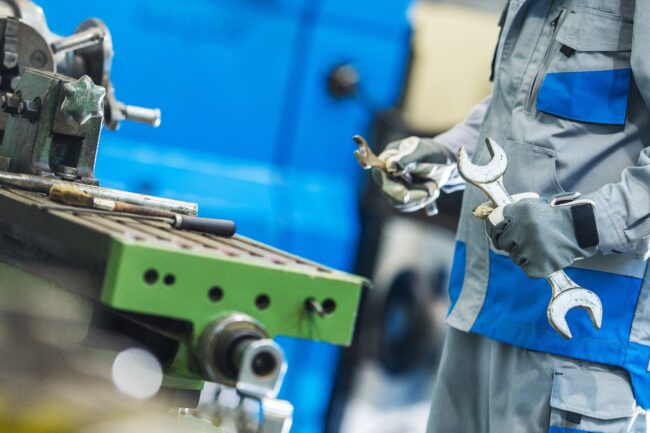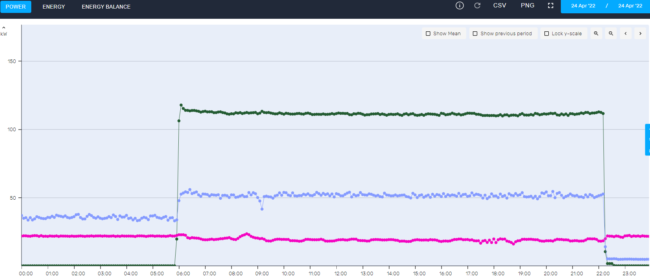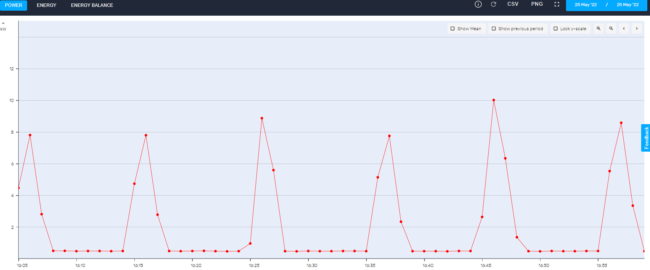What is wasted energy – 5 common types of energy waste
Organizations across the globe are under pressure to cut costs and improve efficiency. One area where companies can make significant savings is by reducing energy waste
Energy waste occurs when energy is produced but not used, or when it is used inefficiently. In many cases, it results in greenhouse gas emissions and other environmental pollution.
There are many different types of energy waste, but some of the most common include:
Standby consumption
Organizations often have devices and appliances that are left on standby, even when they’re not in use. While these devices may not be actively drawing power, they still consume energy – which can add up over time.
Most standby consumption problems occur outside of production time, but this does not exclude the problems that happen during production time. Some organizations use a machine for one hour and then leave it on standby for the next 23 hours.
At Sensorfact, Standby consumption is the biggest contributor to energy waste. Sensorfact’s energy management system detects standby consumption. All data will be shown in Sensorfact’s dashboard where the consultants can determine any anomalies in the current energy expenditure.
Photo: In this case, the machine could have been turned off after 3:30, but certain parts of the machine continue to run unnecessarily.
When the origin of standby consumption is found, an organization has several options. The most common is to install devices that turn off automatically when not in use. Alternatively, organizations can upgrade to more efficient devices that use less energy when on standby.
Sensorfact’s consultants will also recommend the best solution for your organization to reduce standby consumption.
Protocol deviation
In many cases, energy is wasted due to protocol deviation. This occurs when a company deviates from the standard operating procedure, resulting in inefficient use of energy.
For example, a factory may have a protocol that requires the use of machines that are related to other machines. So, these machines should only run when the “main machine” is running.
The energy consultants of Sensorfact interview the companies to get a better understanding of the current procedures. When data shows any anomalies, these will be further investigated. Afterward, the consultant creates a report with his findings and recommendations.
In order to detect protocol deviation, Sensorfact’s Energy Management System monitors the energy consumption of a company’s devices and compares it to the expected consumption. If there is a discrepancy, this may be due to protocol deviation.
The green line is the extruder (the main machine), and the blue and pink lines represent the machines that should run when the extruder is on. Whenever the blue and pink lines are running outside of the green line, it means that something is wrong and energy is being wasted. So, every time the blue and pink lines are running outside of the green line, it is a deviation from the protocol and therefore a waste of energy.
When a protocol deviation occurs, there are a few options for addressing the issue. The first is to upgrade the machines so that they use less energy when running outside of the protocol. Another option is to install devices that automatically turn off when they are not needed.
The most important thing is to make sure that the protocol is followed. This can be done by training employees on the correct procedures and by having someone responsible for monitoring the energy consumption like Sensorfact’s consultants.
Compressor leakage
The compressor is set to a certain pressure and if there are leaks there is a loss of pressure. The compressor tries to compensate for this loss, which means that the compressor switches on for a short period until the set pressure is reached. When the compressor tries to compensate for this leakage, a lot of energy is wasted on this matter.
If there are leaks in the compressor network, this is reflected in the energy pattern of the compressors. If a peak pattern is observed outside production hours (at the moment all machines that require compressed air are turned off), this is due to compressed air leaks.
The red spikes tell us that the compressor is compensating for the leakage.
When Sensorfact’s energy demand management system detects this pattern, they will notify the company about it. Then the organization can take action to fix the leaks.
Poor insulation
No matter how efficient a device is, if it is not well insulated, a lot of energy will be wasted. This is because the heat transfer causes the temperature of the device to drop, which means that the device has to use more energy to maintain the desired temperature.
When an insulation problem is established, there are two ways to combat this issue: by upgrading to better-insulated devices or by installing insulation around the existing devices.
Sensorfact’s consultants can help you determine which option is best for your company.
Non-efficient motors
This is one of the most obvious types of wasted energy since you can see it running even when the equipment is not in use.
Inefficient motors are a big waste of energy because they consume a lot of electricity even when they are not being used. This results in higher energy bills for the company and can also lead to production downtime if the motor is not able to function properly.
Sensorfact’s energy management system will detect an overall high energy consumption. With this information, a consultant could conclude that the problem is linked to inefficient motors.
To fix this issue, the company can invest in more efficient motors. With better motors, less energy is wasted.
Conclusion
There are many types of wasted energy in industry, but these are five of the most common at Sensorfact. By addressing these issues, companies can save money on their energy bills and improve their production process.
If you want to learn more about how Sensorfact can help your company save energy, please contact us. Our consultants will be happy to discuss your specific needs and offer a tailored solution.







